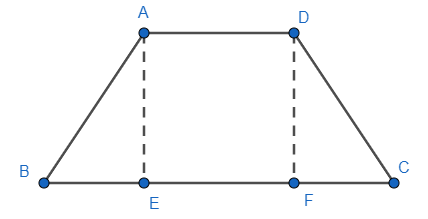Answer
414.6k+ views
Hint: Start by drawing the diagram with all required constructions. Use the property that in isosceles trapezium the lengths of the non-parallel sides are equal.
Complete step-by-step solution -
Let us start with the solution by drawing a diagram of the situation given in the figure along with the required constructions for better visualisation.

In the above figure, we have constructed lines AE and DF such that they are perpendicular to both AD and BC.
Now, as it is given that ABCD is an isosceles trapezium, the lengths of the non-parallel sides must be equal, i.e., AB=DC.
Now, if we focus on $\Delta ABE$ and $\Delta DCF$ , we have
AB=DC
We also know that AE=DF, as the perpendicular distance between two parallel lines are equal at any point on the lines. And $\angle AEB=\angle DFC=90{}^\circ $ , as constructed by us, AE and DF are the heights of the trapezium.
Therefore, using the RHS rule of congruency, we can say that $\Delta ABE\cong \Delta DCF$ .
So, using the rule of CPCT, we can deduce that: $\angle B=\angle C$ .
Therefore, the answer to the above question is option (a).
Note: Some, other important properties of the isosceles trapezium are:
The diagonal of isosceles trapezium bisect each other and the sum of opposite angles is equal to $180{}^\circ $ . All the properties of a trapezium are also valid for isosceles trapezium.
Complete step-by-step solution -
Let us start with the solution by drawing a diagram of the situation given in the figure along with the required constructions for better visualisation.

In the above figure, we have constructed lines AE and DF such that they are perpendicular to both AD and BC.
Now, as it is given that ABCD is an isosceles trapezium, the lengths of the non-parallel sides must be equal, i.e., AB=DC.
Now, if we focus on $\Delta ABE$ and $\Delta DCF$ , we have
AB=DC
We also know that AE=DF, as the perpendicular distance between two parallel lines are equal at any point on the lines. And $\angle AEB=\angle DFC=90{}^\circ $ , as constructed by us, AE and DF are the heights of the trapezium.
Therefore, using the RHS rule of congruency, we can say that $\Delta ABE\cong \Delta DCF$ .
So, using the rule of CPCT, we can deduce that: $\angle B=\angle C$ .
Therefore, the answer to the above question is option (a).
Note: Some, other important properties of the isosceles trapezium are:
The diagonal of isosceles trapezium bisect each other and the sum of opposite angles is equal to $180{}^\circ $ . All the properties of a trapezium are also valid for isosceles trapezium.
Recently Updated Pages
Three beakers labelled as A B and C each containing 25 mL of water were taken A small amount of NaOH anhydrous CuSO4 and NaCl were added to the beakers A B and C respectively It was observed that there was an increase in the temperature of the solutions contained in beakers A and B whereas in case of beaker C the temperature of the solution falls Which one of the following statements isarecorrect i In beakers A and B exothermic process has occurred ii In beakers A and B endothermic process has occurred iii In beaker C exothermic process has occurred iv In beaker C endothermic process has occurred

The branch of science which deals with nature and natural class 10 physics CBSE

The Equation xxx + 2 is Satisfied when x is Equal to Class 10 Maths

Define absolute refractive index of a medium

Find out what do the algal bloom and redtides sign class 10 biology CBSE

Prove that the function fleft x right xn is continuous class 12 maths CBSE

Trending doubts
Difference Between Plant Cell and Animal Cell

Difference between Prokaryotic cell and Eukaryotic class 11 biology CBSE

Fill the blanks with the suitable prepositions 1 The class 9 english CBSE

Change the following sentences into negative and interrogative class 10 english CBSE

Summary of the poem Where the Mind is Without Fear class 8 english CBSE

Give 10 examples for herbs , shrubs , climbers , creepers

Write an application to the principal requesting five class 10 english CBSE

What organs are located on the left side of your body class 11 biology CBSE

What is the z value for a 90 95 and 99 percent confidence class 11 maths CBSE



